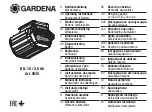
1. The DC charging receptacle does not grip the DC output plug tightly, is loose or does not make a
good electrical connection.
2. The DC output plug and/or charging receptacle feel hotter than normal.
3. The DC output plug pins or receptacle contacts are bent, corroded or are dark or bluish in
appearance.
4. The DC output plug, cords, receptacle or equipment charging wiring are cut, worn, broken, or
have any exposed conductors.
5. The DC output plug, cords, charger or receptacles are damaged or distressed in any way.
Using the charger with any of the above symptoms could result in a fire, property damage, or
personal injury.
Have your distributor, dealer or other qualified service technician repair or replace worn or
damaged parts immediately. Repairs should not be attempted by people who are not qualified.
Check that there is no open flame or electrical spark in the area.
!
CAUTION
-
Improper AC power can damage the charger. Consult data plate on the charger to
verify AC input power requirements. Note CAUTION in Installation Section.
5
.
Theory of Operation
The control circuit monitors battery voltage and charging current. A microprocessor and silicon
controlled rectifiers (SCR's) are employed to realize a modified 2-step-E-I or 3-step I-E-I charge
profile.
1] CONSTANT START CURRENT
- Charge current to the batteries is maintained at a constant value
during initial charge stage to ensure capacity is rapidly returned to discharged batteries until
battery voltage per cell reaches a specified level.
2] CONSTANT VOLTAGE
- To rapidly charge the batteries without exposing them to both high
current and high voltage, the battery voltage is maintained at a steady voltage while being charged
with decreasing current.







































